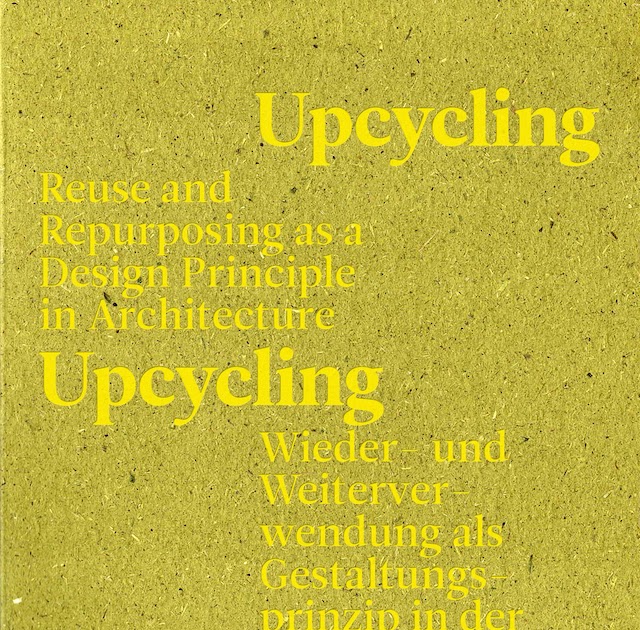Upcycling
Upcycling: Reuse and Repurposing as a Design Principle in ArchitectureDaniel Stockhammer (Editor)Triest, March 2020Paperback | 6-1/4 x 8-1/4 inches | 204 pages | 230 illustrations | German/English | ISBN: 9783038630463 | $54.00PUBLISHER'S DESCRIPTION:Exploitation and destruction of the environment call for an inevitable paradigm shift as regards our resource consumption: “innovative” building will have to break away from the dogma of new build. We need to reconsider the existing building stock as a wealth of resources and ideas, just as we should understand recycling and upcycling building stock as architectonic potential.New approaches in architecture reveal a trend towards concepts of the frequently used but theoretically and historically rarely defined term upcycling. In that context, one often forgets that the history of building has also always been a history of, firstly, recycled and upcycled building materials and components, and secondly, of building knowledge and building styles.Comprehending buildings as a part of a social change process poses a challenge to our current habits and modern concept of unambiguity, seclusion and authorship of architecture. This publication explores the potential of historical concepts of upcycling – the qualitative recycling of buildings and building components – and confronts them with new developments in architectural and building practice. Importantly, the authors look into the question of whether and how new solutions could be found for future architecture. “Recycling and upcycling” should not be a matter of idealism, but rather present an argument for economy and the quality of structure and design.Daniel Stockhammer has earned diplomas from schools of architecture in Vienna, Zurich and Winterthur. ... He is assistant professor at the Institute of Architecture and Planning, University of Liechtenstein and heads the design studio "Upcycling" with Cornelia Faisst.REFERRAL LINKS: dDAB COMMENTARY:The cover of Martin Pawley's 1975 book Garbage Housing features a grainy photograph of a house on a yellow background, with the house positioned above a collage of cans, bottles, and other detritus. Although the house looks conventional, with a gabled form and square window, the textured walls — not to mention the title of the book — hint at something exceptional. The house is actually Alfred Heineken’s WOBO house that was designed a decade earlier by architect N. John Habraken with beer bottles he devised for Heineken, bottles that could be "upcycled" from holding beer to holding up the roof of a house. Habraken designed the bottles with concave bottoms (much like wine bottles) that enabled the bottles to be nested in rows and then stacked like bricks. One hundred thousand WOBO bottles were manufactured but just one such house, in Heineken's own garden, was built from them, a victim of corporate marketing.In 1966, just a couple years after Heineken's WOBO house, the Horten department store, designed by Rhode Kellermann Wawrowsky (RKW), was built in Hamm, Germany. The outer layer of the store was covered in molded aluminum tiles that gave the building its modern, textured appearance. Fast forward to 2007 and the unfortunate demolition of the 41-year-old department store: fortunately, many of the Horten tiles were saved and sold for reuse. KARO* architekten worked on one project (the only one I'm aware of) that reused the tiles: the award-winning Open-Air Library located in "a socially depressed" area of Magdeburg, Germany. Previously the library on the same site was temporary, made from milk crates. With the Horten tiles, the Open-Air Library became permanent, another example of "upcycling" a material, or in this case a component.Both of these examples of upcycling are found, appropriately enough, in Upcycling, which looks at historical and recent examples (almost exclusively in Europe, especially German-speaking countries) of materials being reused in ways that does not downgrade their physical makeup or their architectural potential. It is an optimistic, if academically grounded book whose message even extends to its cover; the second edition, which the publisher sent me, is recycled "Gmund Bio Cycle made from fast growing fibers and green waste." If Pawley's 45-year-old book on "garbage housing" put the image of such on its cover, this book makes its subject into the cover.Inside the book are a dozen contributions in two sections: "History of Reuse and Repurposing" and "Reuse and Repurposing of History?" They follow editor Daniel Stockhammer's excellent introduction, which highlights the increasing attention given to adaptive reuse and other ways of preserving materials over the long-held focus on new buildings valued for formal innovation. It's a refreshing shift toward an approach that has been done for centuries, as the examples in the book show, but is being discussed more and more as climate change and resource scarcity increases. More than having a firm grounding in

Paperback | 6-1/4 x 8-1/4 inches | 204 pages | 230 illustrations | German/English | ISBN: 9783038630463 | $54.00
PUBLISHER'S DESCRIPTION:
REFERRAL LINKS:
SPREADS:







